Among the gourami, there is a wide variety of all kinds of species that differ from each other in size and color, so every fan of the labyrinth fish will certainly find the same “his”. Honey gourami is very popular among aquarists, the smallest of all fish of this family, it reaches 4 cm in length, sometimes it can grow up to 7, but in practice this happens extremely rarely.
Characteristic
Honey gourami is a miniature and very beautiful fish, which, without a doubt, can become a real decoration of any aquarium. This variety of aquatic inhabitants got its name due to the unusual shade that appears in males during mating. By the way, when these fish were only open, due to the difference in the colors of males and females, they were even assigned to different species at first.
Gourami are the closest relatives of Lalius, however, they are much less popular than the latter - most likely, the reason is that during the sale the honey gourami looks rather faded, and in order to fully reveal its hue, it takes time to adapt.
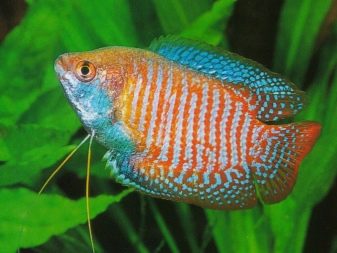
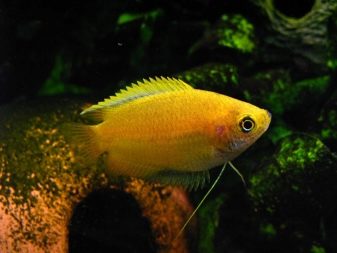
Golden subspecies, which is considered one of the varieties of honey, are very popular with aquarists.
The golden fish is distinguished by a rich yellow-orange color of the scales and red side fins, the dorsal is colored in a lemon shade. In an adult male, a dark blue hue may be present on the abdomen, which in some cases reaches black. This tone also goes to the front of the anal fin and extends to the lower part of the head of the individual.
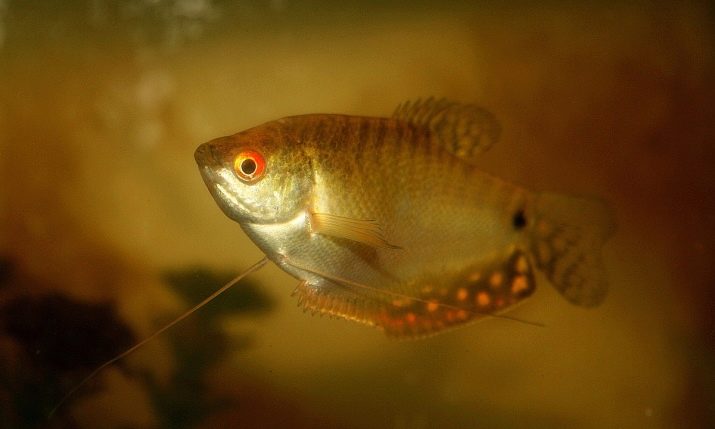
Like all other labyrinth fishes, gourams breathe air from the atmosphere, therefore it is necessary to arrange access to the surface of the water in the aquarium. However, these creatures are also able to inhale dissolved oxygen - nature created them in such a way that they are able to survive in the most difficult conditions, where other species simply die. Honey gourams are famous for their unpretentiousness, so beginner aquarists appreciate them - they quickly adapt to a changing habitat, have excellent appetite, but at the same time they are absolutely not picky about food.
In most cases, fish grow up to 4 cm. The body of the honey gourami is compressed along the lateral line, it is slightly similar in structure to the body of the lalius, but slightly more narrowed, and the fins are smaller, the abdominal ones completely transformed into threads, with which the fish feel the whole space around them.
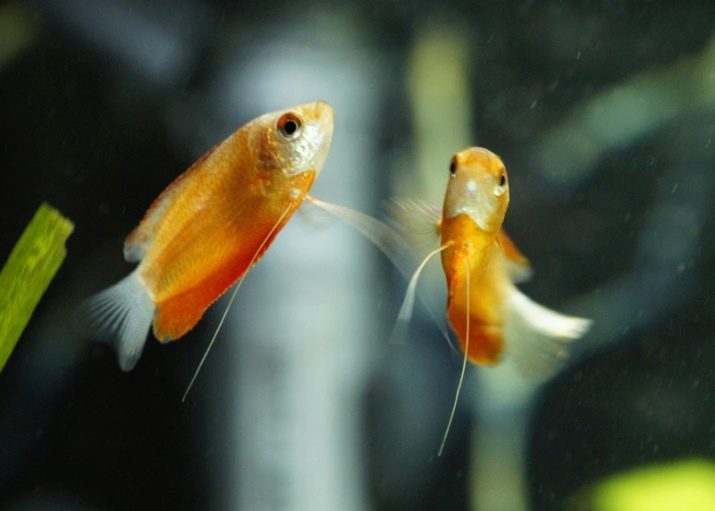
Honey gourami are quite peaceful creatures. Their maintenance is very simple even for people who do not have experience in breeding fish. They easily adapt to life in small tanks - so, for one individual, a capacity of 10 liters is quite enough.
When creating a favorable habitat they live up to 4-5 years.
Care
Gourami prefer to stay at the very surface of the water, so it is important that the room temperature and the level of water heating in the artificial pond match as much as possible, as labyrinth fish breathe normal oxygen, and if there is too much difference, they can damage their labyrinth apparatus.
It is advisable to install a compressor that will provide high-quality aeration of the water; in addition, water should be changed weekly by about 25-30%. Honey gourami prefers pure water, so it will be useful to establish high-quality and powerful filter installation.

Gurams love shady areas, prefer to stay in shaded places. They do not need too bright light, although lighting in the tank should still be necessary to maintain the full growth and development of water plants. The optimal solution would be to use fluorescent lamps with a power of 0.3-0.4 W / l. Be sure to start plants floating on the surface of the water - they will create additional shading, but do not go too far with them, remember that fish should always have access to the top.
Any soil can be used, but honey gourami looks most effective against a dark background, be sure to put driftwood, grottoes and caves at the bottom - the fish are very shy and shy, so they spend a lot of time in shelters. Be sure to plant long-leaved plants - usually underneath them gouras equip their burrows.

The optimum temperature will be + 24 ... 28 degrees Celsius. This fish comes from India, and the rivers in this country are warm, so such conditions will be the most comfortable for the gourami. Acidity should vary from 6 to 7.5 units, there are no strict requirements for rigidity, parameters from 4 to 15 are allowed.
There are usually no difficulties with honey gourami nutrition - these are omnivorous fish, therefore they are able to eat all kinds of dry, frozen and live food. Experts recommend using cereal as the basis of the diet, and offer seafood and crustaceans to pets as a top dressing. But one should be careful with a tubule - their frequent use often becomes the cause of fish obesity and their subsequent death.
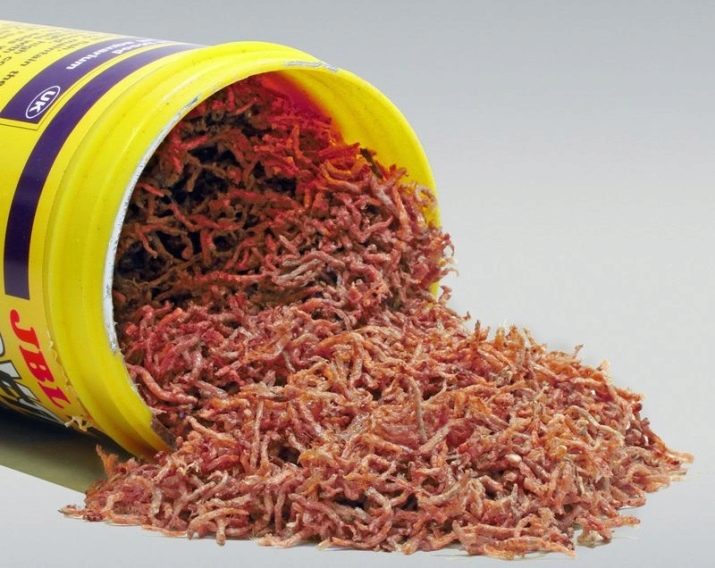
Food should be offered twice a day, once a week, you can arrange for pets a fasting day.
Compatibility
Gurams are trouble-free neighbors, although due to their natural shyness they need time to adapt to the new “team”. These fish are distinguished by their peaceful disposition, therefore they will not be the first to attack, but they can become a victim of too aggressive or active neighbors, who often inflict damage by the gourami or simply take away their food.
Conflicts in honey gourami most often arise with Laliuses, since these animals are similar in appearance, but Llius is much more cocky.
Gurami are not schooling fish, they live either singly or as a pair. However, these pets may well coexist in groups of 4-5 individuals - as a rule, in such cases a certain hierarchy is established in the groups, one of the males dominates and drives away all competitors.
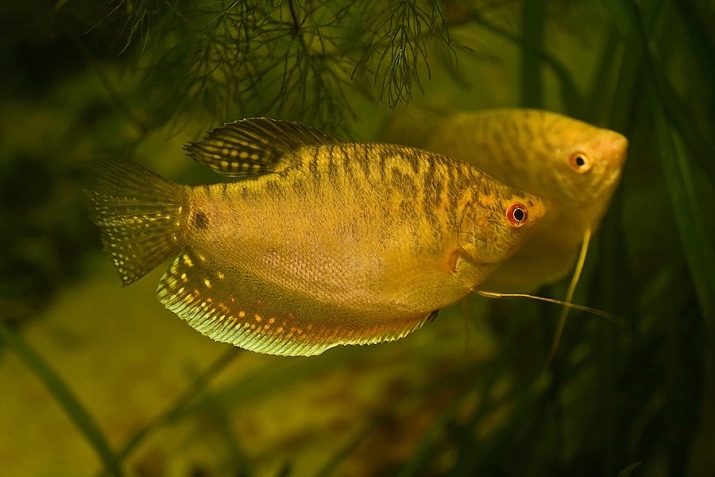
Breeding
Breeding gourami at home is quite simple. Like all labyrinth fishes, this pet builds its nests out of foam, unlike their relatives of Lalius, who need fragments of floating plants. They build a secluded place for spawning under the large leaves of any water plant.
Male honey gourami are distinguished by their tolerance for females, and this, by the way, is another difference between these fishes and Laliuses - the latter are quite capable of slaughtering their female individual if she has nowhere to hide.
For spawning, fish are moved to an aquarium with a volume of 40 or more liters, the water level should be kept at 15-20 cm, the optimum temperature is slightly increased to + 27 ... 30 degrees Celsius.
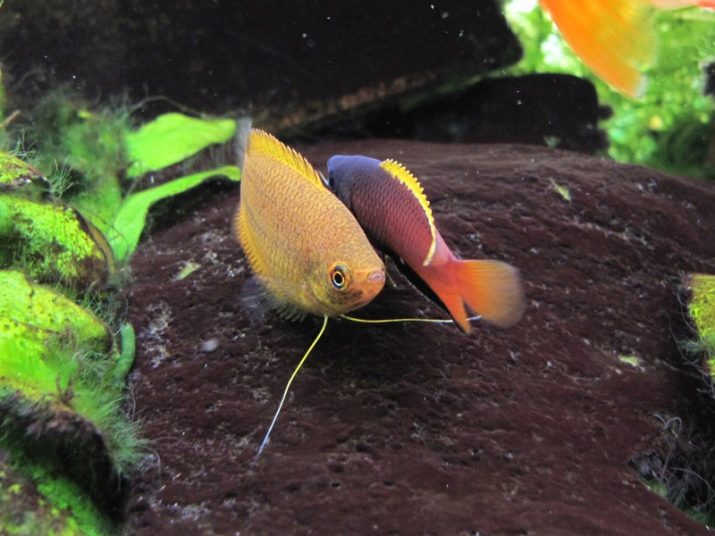
The selected group of fish is plentifully fed with live food, while the female ready for spawning is much more fat. At this point, the male usually proceeds to the construction of the nest. When it is ready, the partner begins to attract the female in various ways, showing her all his attractiveness.
At one time, the female lays about 20 eggs, which are then inseminated by the male. After that, the latter types them in the mouth and carefully moves them into the nest. The process is repeated several times - just for spawning, each female lays from 200 to 300 eggs.
Immediately after the process is completed, the female is transplanted back to the general aquariumotherwise, it will stop the male from controlling the state of the nest - the latter guard the eggs and watch her until the juveniles are hatching. As a rule, this moment comes after 1.5 daysafter which the male is also resettled back to the general aquarium.
After about three days, the fry begin to swim and eat - the first 7-10 days they are fed with special “live dust” or infusoria, food is offered several times a day, since hunger has a detrimental effect on the state of young animals.
Two weeks later, the fish are transferred to the feeding of Artemia nauplii, as pets grow, young animals must be sorted - otherwise manifestations of cannibalism are not excluded.

Disease
Golden gourami are predisposed to oodinosis, while in adults it can be present in hidden form for several years, without affecting the quality of life of pets, but young animals are at risk. Oodinosis is caused by flagellated Oodinium - they climb into the fins, gills, under the skin and in the oral mucosa. Sick fish can be easily identified by a rough head with a slight golden dusting, as well as glued brown fins and the same dirty color with spots throughout the body.
The affected fish gourami clogs into a corner and intensively rubs against decorative elements, protruding parts of equipment and plants.
Typically, copper sulfate, Bicillin, sodium chloride, malachite green or hydrochloride are added to the water for treatment. therapy is carried out in the dark, since pathogens are to some extent related to plants.
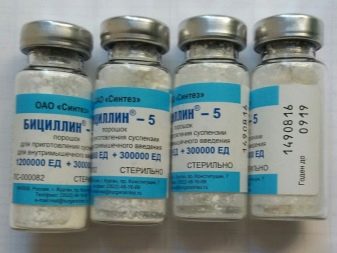
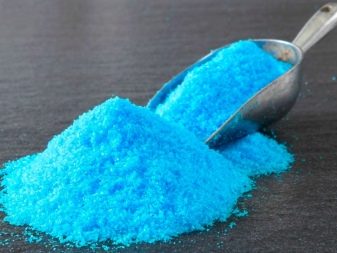
Very often, new inhabitants enter the aquarium, which is why you need to meticulously inspect the fish when buying - if she has torn, poorly straightened fins and a broken off antennae, then it is better to immediately refuse such an individual. At the same time, the excessive pallor of the color should not scare you - it only indicates the state of stress in the fish, as soon as the pet gets a permanent place of residence, after a while bright shades will return to it again.
Anyway do not neglect quarantine - before planting a new fish in the aquarium, it is desirable to keep it in a separate container for 3-4 weeks, during this period daily baths will be useful from a mixture of "Bicillin", "Rivanol" and greeneryThis treatment lasts about 15 minutes.
If you follow these simple tips, your honey gourami will remain healthy and for several years will delight you with their unusual color.
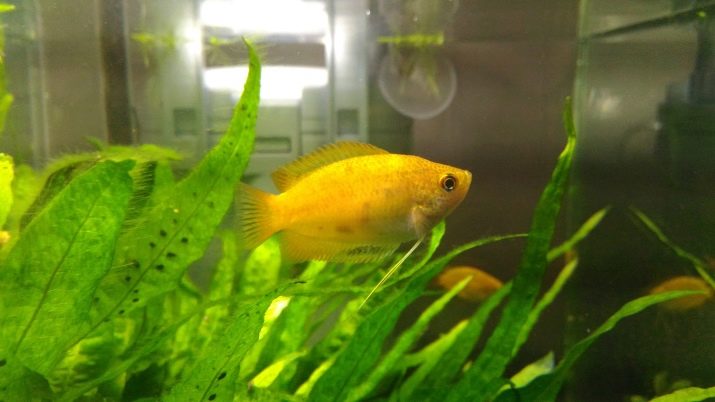
You can look at honey gourami during the spawning period further.










